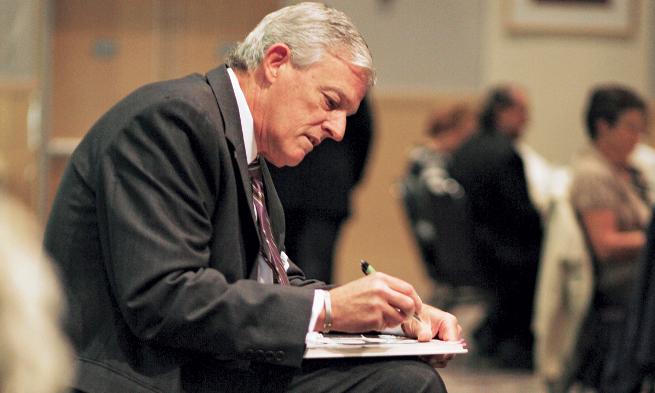The Rose legacy
Being the Change
“The greatest accomplishments of JMU are the enriched lives and enhanced intellects and talents of the students who become JMU graduates. The lives they lead, the values they teach others, the contributions they make to our future are far more meaningful than what is often quantified as a measure of success. Dr. Rose knew this and has, in his blood, an unshakable commitment to a high–quality undergraduate experience.” — Meredith Strohm Gunter, former JMU Board of Visitors rector
During the 14–year tenure of President Linwood H. Rose, JMU’s growth has been phenomenal. Rose conferred 56,893 degrees as president, a number that represents almost half of all the degrees conferred at Madison — 123,486 — since 1911. That’s a lot of graduation handshakes, personal stories and JMU successes.
Enrollment has increased exponentially, along with a corresponding growth in academic programs and campus. Through all of these upward pressures, Madison academic excellence has outpaced growth. Teaching remains the No. 1 priority of the faculty. The student–to–faculty ratio has improved from 19.2:1 in 1998 to 16:1 today — no mean feat of presidential leadership in the face of such growth. Phi Beta Kappa has just marked its third year on campus. The honors program has intensified. The number of residential learning communities has increased. JMU has reached the top 10 nationally for graduation rates. Traditionally strong faculty scholarship, research and artistry have entered a new order of magnitude. And so have mentored undergraduate research experiences, hands–on internships, student–teaching placements and service–learning opportunities, which number in the thousands each year.
President Rose’s most profound accomplishment, however, might just have been his first — bringing the entire university around a strong, clear–cut, inspiring mission statement: “We are a community committed to preparing students to be educated and enlightened citizens who lead productive and meaningful lives.”
The mighty academic, social and personal implications of that statement have powered an era. Those words have fueled the intellect, the compassion and the enthusiasm of professors, staff members, students, alumni, donors and friends who know they are on this planet for reasons beyond their own well being: To do more. To transcend the mundane. To change the status quo. To touch lives. To Be the Change.
During Rose’s tenure, students, professors, alumni and staff members responded with numerous individual, group and campuswide efforts to national tragedies like Sept. 11, 2001, Hurricane Katrina and the Virginia Tech shootings. Quiet, unlauded Be the Change moments also happen in the classroom and through service to others — proving that Madison is a community that cares about the needs of others. This societal awareness is no accident.
The president has steered the university firmly toward developing programs that benefit the public good. He has personally championed the value of higher education as the key to producing an enlightened citizenry who can sustain democracy and solve its greatest issues. Rose has helped JMU solidify a position of national prominence and established JMU as a leader in institutional performance measurement, accountability and assessment of student learning.
All the while, Madison’s intimate atmosphere persists. JMU students’ overall satisfaction with the university has increased from 92 percent to 97 percent, and students who report that they are satisfied with the university’s concern for them as individuals has increased from 72 percent in 1998 to 88 percent today.
Steady, attentive to detail, quiet and uncomfortable with what he considers undue personal attention, Rose has created the framework for the Madison community to thrive and prefers to let the evidence of success — and more importantly, the success of others — speak for itself.
President Rose said in his inaugural address that the JMU presidency is the best one in the nation.
